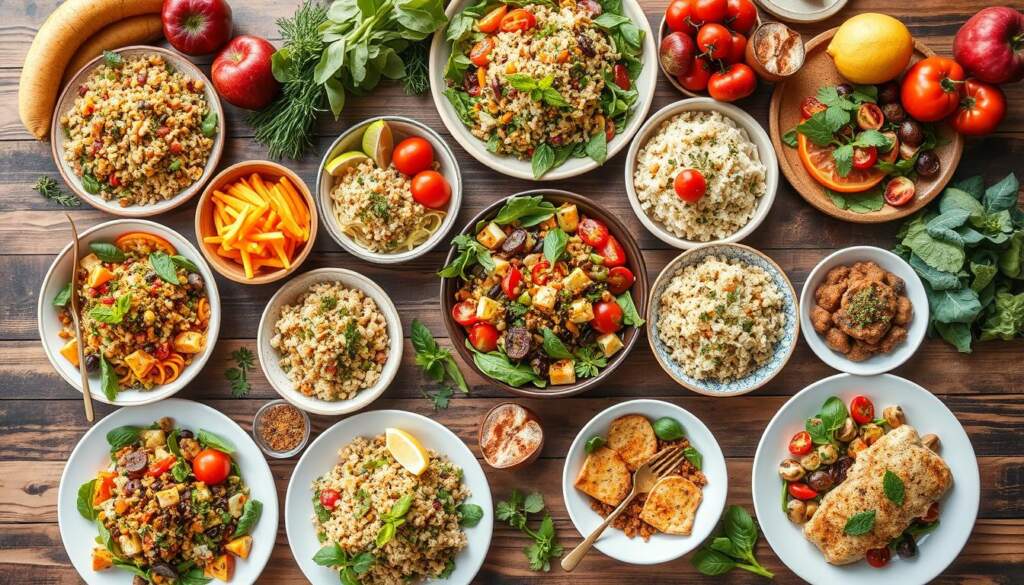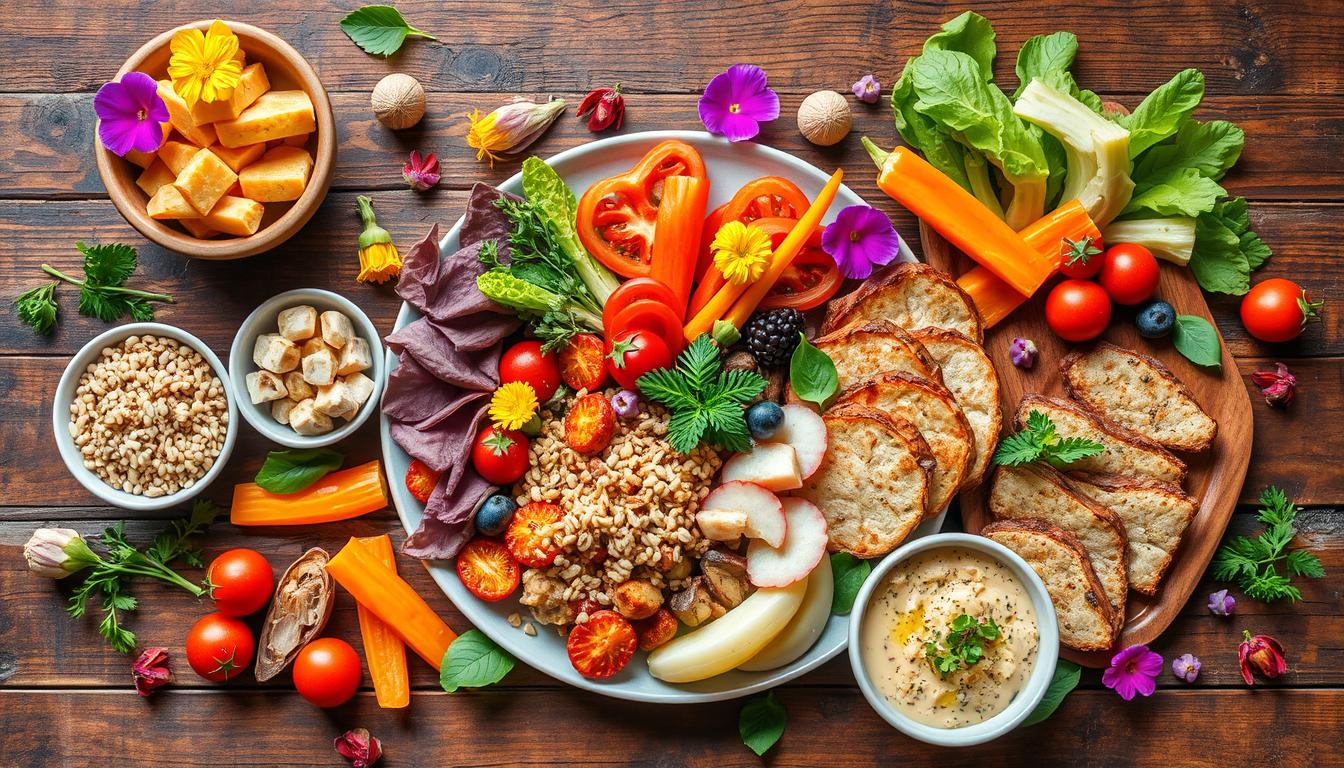Joyful nutrition habits are not just about the foods we eat, but how we approach our meals. Chef and dietitian Lexi Linsenman believes that transforming your diet can be a delightful, artistic endeavor. This is evident as she shares her passion for flavorful, nutritious cuisine and sustainable agricultural practices at the Columbia Center for Urban Agriculture. From local harvests to creative presentation, Linsenman provides us with healthy meal ideas designed to inspire and invigorate our daily eating routine.
Engaging with the right resources and a supportive community can make the journey to better eating habits an enjoyable one. Utilizing fresh, locally-sourced produce not only enhances flavor and nutritional value1, but also connects you with the local ecosystem and its seasonal rhythms. Whether it’s starting small with a few vegetables in your backyard, exploring farmers’ markets, or even joining a community garden, these steps can lead to substantial improvements in how you perceive and consume food1.
However, the thrill of healthy eating doesn’t stop at acquisition; the flare of high-heat cooking methods brings out a robust depth of flavor1, while aromatic spices keep your taste buds engaged and excited1. With a hint of inspiration from social media or cooking alongside someone special, every meal becomes a canvas for your culinary creativity1.
As you embrace these tips and integrate them into your routine, you’ll discover that a healthy diet is not just about the nourishment—it’s about the experience. So, let’s dive in and spice up your meals with a dash of enjoyment and a sprinkle of community spirit!
Key Takeaways
- Find joy in the artistry of cooking and meal preparation.
- Source locally to maximize flavor and nutritional benefits1.
- Introduce high-heat cooking for tastier and more textured dishes1.
- Explore diverse and colorful healthy meal ideas for continued excitement.
- Lean on a community of like-minded individuals and resources for support and inspiration1.
Discover the Joy of Local Produce
Embracing a diet rich in locally grown vegetables not only enhances your health but also supports regenerative agriculture, fostering a sustainable environment.
The MyPlate, MyWins campaign is a valuable resource, offering guidance on incorporating small, manageable changes, including integrating more local produce into your diet for long-lasting health benefits2.
Moreover, local farmers markets have become pivotal in enriching our diets with diverse and nutritious food options. These markets, supported by initiatives like MyPlate, MyState, encourage personalizing our meals with local and seasonal foods, thus promoting not only nutrition but also the joy of supporting local economies2.
For families, incorporating fun activities such as the MyPlate Grocery Store Bingo can turn a routine shopping trip into an educational experience about healthy food choices, highlighting the importance of produce prescriptions in preventing lifestyle-related diseases2. Local produce is not just food; it’s a lesson in health, ecology, and community.
Using the MyPlate, MyState toolkit, educators can introduce young minds to the concept of eating local, crafting lesson plans that include garden-based learning, thus inspiring the next generation to partake in regenerative agriculture from a young age2. It’s about creating a sustainable future where local markets thrive and communities benefit from fresh, nutritious produce.
By actively choosing local foods, as advised by MyPlate, MyState, consumers foster a deep connection with their food’s source, promoting a healthier, more sustainable lifestyle2. To integrate local vegetables effectively into daily meals, starting with a salad can be a simple yet impactful approach3. Salad ingredients can vary widely, from the humble radish to the more exotic artichoke, each adding a unique twist and a burst of nutrition to any meal3.
Replacing common carb-heavy sides with vegetable-based alternatives like zucchini noodles or cauliflower rice can transform an ordinary meal into a celebration of local bounty while addressing the common struggle of incorporating enough vegetables into one’s diet3. For those in a rush, replacing traditional wraps with lettuce or other leafy greens provides a quick, nutritious meal filled with a variety of local vegetables, aligning well with produce prescription programs aiming to increase vegetable intake among communities3.
| Activity | Benefit |
|---|---|
| Shopping at local farmers markets | Access to fresh, seasonal produce; supports local farmers |
| Participating in produce prescriptions | Promotes health equity; increases vegetable consumption |
| Engaging in gardening or community gardens | Encourages self-sufficiency; educates about regenerative agriculture |
| Using educational resources like MyPlate, MyState | Teaches the significance of local foods in diet; supports educational engagement |
By valuing the produce from local farmers markets and engaging in activities that promote regenerative agriculture, communities not only enjoy fresher, more nutritious meals but also contribute to a resilient food system. Discover the joys and benefits of local produce today!
Integral Role of Meal Presentation in Enjoyment
The art of meal presentation significantly impacts our perception and enjoyment of food, injecting a visual feast that complements the culinary experience. By skillfully arranging visually appealing foods on the plate, chefs transform simple ingredients into a canvas of taste and texture.
Food presentation is one of the main indicators of how enjoyable a meal will be, where colors and arrangement play crucial roles in enhancing the dining experience4. For instance, incorporating vibrant colors through fruits and vegetables not only satisfies nutritional needs but also turns meals into visually captivating artworks. This not only attracts the eye but also stimulates appetite and expectation4.
Incorporating Color Through Fruits and Vegetables
Elevating dishes through the use of colorful ingredients is a practical approach to enhance both the aesthetic and the health quotient of meals. A palette of greens, reds, yellows, and purples not only makes the dish more appetizing but also ensures a variety of nutrients. Lexi Linsenman suggests using a range of hues on the plate, complemented by toppings like diced nuts, herbs, and citrus zest for added texture and flavor, successfully merging culinary artistry with nutrition.
The Aesthetic Appeal of Edible Flowers in Cuisine
Edible flowers such as borage, dandelion, nasturtium, squash blossom, sunflower, and zinnia add not only a burst of color but also a subtle array of flavors, which can distinguish a simple dish as an example of high culinary artistry4. These ingredients, when placed thoughtfully, upgrade a standard meal into a masterpiece pleasing to the eye and the palate. It’s the meticulous attention to such details that communicates care and quality to the consumer, concurrently encouraging a slower, more mindful eating experience4.
Moreover, effective meal presentation practices like building height on the plate and using contrast in colors make the food visually more dynamic and inviting. Such techniques are not just about aesthetic pleasure but are also strategies to make the food taste better and the overall dining experience more memorable4.
| Component | Role in Meal Presentation | Benefits |
|---|---|---|
| Color | Enhances visual appeal | Stimulates appetite, increases enjoyment |
| Texture | Adds depth and complexity | Improves sensory experience of the meal |
| Edible Flowers | Provides unique flavors and decoration | Elevates dish uniqueness, encourages mindful eating |
Ultimately, the care put into meal presentation reflects an understanding of the psychological effects of visually appealing foods, where every element on the plate plays a vital role in creating an inviting and satisfying culinary experience4.
Embrace High-Heat Cooking Techniques for Flavorful Dishes
To maintain a delightful and health-conscious diet, exploring high-heat cooking techniques not only accelerates the cooking process but significantly empowers flavor enhancement. High-heat methods like stir-frying, broiling, and grilling integrate both zest and texture into everyday meals, offering a palatable experience that can transform nutritious cooking from mundane to exciting.


Choosing the Right Oils for High-Heat Cooking
The selection of appropriate oils with a high smoke point is pivotal for successful high-heat cooking. Oils such as avocado, canola, and sunflower not only withstand the rigors of high temperature without breaking down but also contribute to the overall health benefits of the dishes. Stir-frying, a proficient method for quick meal preparation, is popular in various cuisines and particularly benefits from oils that maintain their structural integrity under high heat5.
Cooking Methods That Enhance Food Texture and Taste
The art of broiling and grilling, where food is exposed directly to high temperatures, allows for a rapid cooking process that locks in flavor and expels excessive fats. Such methods are conducive not only to flavor enhancement but also to producing meals that are less laden with unhealthy fats. Foods like thin cuts of meat, vegetables, and seafood are especially suited for these techniques, as seen in the caramelized crusts and juicy interiors that are often achieved5.
Embracing these high-heat techniques ensures meals are not only cooked efficiently but are also robust in flavor and nutrition, reinforcing the joy of eating well. Utilizing oils with high smoke points and engaging in dynamic cooking methods are foundational to mastering the culinary art of healthful, flavor-packed meals.
Variety: The Spice of a Healthy Diet
Delving into a world of meal diversity and diet variety not only enhances the joy of eating but significantly contributes to nourishment and well-being. By integrating nutritious recipes that incorporate a wide range of ingredients, you can effortlessly boost your intake of essential nutrients while keeping your meals exciting and enjoyable.
Avocados, for example, are a powerhouse of heart-healthy monounsaturated fats and are packed with fiber, vitamins C, E, K, and B-66. Watermelon, consisting of 92% water, is perfect for hydration and adds a refreshing twist to any diet without compromising calorie intake6. Such choices, according to recent studies, mirror the positive correlation between a varied diet and an enhanced metabolic profile6.
Incorporating small yet powerful elements like microgreens or spices such as turmeric and chilies can significantly elevate the nutritional value and taste of any meal67. Microgreens are dense in nutrients and antioxidants, reducing chronic disease risks, while spices offer anti-inflammatory benefits and enhanced digestion7.


Healthy eating support systems are vital in maintaining this dietary enthusiasm. Collaborating with community resources like local farmer’s markets or online communities dedicated to healthy living can provide an abundance of ideas and motivation8.
| Ingredient | Benefits | Example Use |
|---|---|---|
| Avocados | Reduces risk of heart disease, Provides essential vitamins6 | Salads, Sandwich spreads |
| Watermelon | Hydration, Weight management6 | Fruit salads, Juices |
| Microgreens | Rich in antioxidants, Enhances flavor6 | Toppings on soups, Omelets |
| Turmeric | Anti-inflammatory, Supports digestion7 | Curries, Golden milk |
By consistently integrating a variety of ingredients and flavors, such as those provided by nutritious staples like oats and peanuts, into daily meals, we ensure not just tastefulness but also heart-healthy benefits and sustained energy, making every meal not only a gustatory delight but a step towards long-term health6.
Ultimately, the goal of achieving and maintaining health through diet variety and healthy eating support is not about rigorous restrictions but about creating a balance that supports body, mind, and palate8. By embracing the full spectrum of available foods, particularly those rich in nutrients and flavor, you can enjoy a rich, diversified diet that encourages both health and happiness.
Conclusion
In wrapping up our exploration of making sustainable healthy eating a joyful and engaging part of daily life, we’ve seen how weaving culinary creativity into our meals using an array of local and vibrant ingredients can act as a catalyst for dietary transformation. Small, purposeful changes, such as opting for fruits and vegetables rich in color, can lead to significant health benefits, including a lowered risk of chronic diseases like heart disease, diabetes, and cancer9. Moreover, embracing whole grains and lean proteins not only contributes to maintaining a healthy weight but also increases energy levels, thereby enhancing alertness and focus9.
Achieving a balance between taste and nutritional value is key; high-heat cooking techniques that enhance flavors and textures, along with the incorporation of a variety of global spices, can keep our taste buds interested and make the concept of nutrition education an exciting endeavor rather than a mundane task. For those aiming for better health, remember that even 60 minutes of moderate physical activity per week can offer benefits, with a goal of 150 minutes to maintain or improve overall well-being10. Regular, moderate exercise combined with hydration—drinking at least 8 cups of water daily—is fundamental in supporting our dietary efforts11.
Navigating the path to sustainability in our diets also means employing practical strategies such as buying seasonal fruits and vegetables or using precut options for convenience to facilitate healthy meal preparation amidst time constraints10. By cooking more meals at home, we gain control over our ingredients, steering clear of processed foods and unnecessary additives, which is a cornerstone of fostering healthier eating habits11. Ultimately, our health journey is reinforced by practicing moderation and not skipping meals to avoid overeating later, ensuring we can enjoy our favorite foods without deprivation11. A supportive environment, underscored by engaging in nutrition education, equips us to be proactive in our culinary creativity, shaping a transformative and sustainable approach to what we eat—proving that healthy eating need not be a chore, but can indeed be a fulfilling, pleasurable experience.
FAQ
How can I make healthy eating more enjoyable?
Why are locally grown vegetables a better choice?
What can I do to liven up my meals visually?
How do edible flowers enhance my dishes?
What oils should I use for high-heat cooking?
What high-heat cooking methods are best for making flavorful dishes?
How does meal diversity contribute to a healthy diet?
Where can I find support for pursuing a healthy diet?
Source Links
- Healthy Eating Doesn’t Have to Be Boring — 6 Ways to Make It Fun | Live Healthy – https://livehealthy.muhealth.org/stories/healthy-eating-doesnt-have-be-boring-6-ways-make-it-fun
- MyPlate, MyState Helps You Bring the Joy of Local Foods to the Classroom – https://www.usda.gov/media/blog/2016/10/05/myplate-mystate-helps-you-bring-joy-local-foods-classroom
- How to Finally Eat More Veggies … And Enjoy It! – https://www.weightandwellness.com/resources/articles-and-videos/how-finally-eat-more-veggies-and-enjoy-it
- Why Does Food Presentation Matter So Much? – https://adc-us.com/blog/why-food-presentation-matters/
- home – https://buschslocal.com/home/healthy-cooking-methods/
- Tips For Eating Healthy | AgLab – https://aglab.ars.usda.gov/the-nutrition-corner/tips-for-eating-healthy
- How to Make Healthy Meals More Flavorful – Consumer Reports – https://www.consumerreports.org/health/healthy-eating/how-to-make-healthy-meals-more-flavorful-a5800541088/
- 8 TIPS TO MAKE HEALTHY EATING EASY AND TASTY – https://culinaryworks.com/8-tips-to-make-healthy-eating-easy-and-tasty/
- Develop healthy eating habits for optimal health. – https://dwpsgrnoida.com/healthy-eating-habits-why-its-important-and-how-to-develop-them/
- Keep Active & Eat Healthy to Improve Well-being & Feel Great – NIDDK – https://www.niddk.nih.gov/health-information/weight-management/keep-active-eat-healthy-feel-great
- How to Start Eating Healthy? – https://cleaneatz.com/blog/how-to-start-eating-healthy





